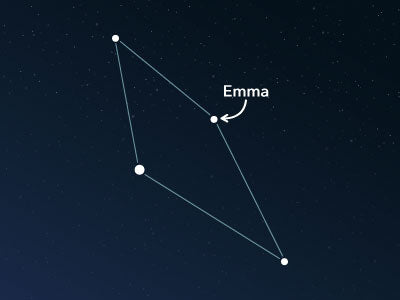The constellation Reticulum
Caractéristiques
- Nom latin
- Reticulum
- Hémisphère
- Hémisphère sud
- Visibilité
- October - January
- Région
- 114 deg²
- Étoile la plus brillante
- α Reticuli (HIP number 19780)
- Spécialités
- Galaxies

The Reticulum symbolizes a net or reticle and is a small inconspicuous constellation in the south. It was introduced in the 17th century and renamed to its current name over 100 years later. There are only a few deep-sky objects located in its area.
Hemisphere, visibility, and area
The constellation Reticulum lies in the southern celestial sky and can be seen from all regions of the southern hemisphere. North of the equator, it can only be observed fully up to the 23rd latitude. That corresponds to places such as Havana in Cuba or Kolkata in India. Hence, the constellation is never visible in the USA, Canada, or Central Europe.
The months from October to January offer the best view of the constellation.
Reticulum has an area of only about 114 square degrees, making it the sixth-smallest constellation compared to all other 88 constellations.
In star maps, the constellation is often visualized using the four main stars, which are connected to each other in a diamond-shaped square. The brightest of the four stars bears the Latin name α Reticuli (Alpha Reticuli). It has an apparent magnitude of only about 3.3. It is a double-star system whose main star shines yellow.
Since the other stars are still fainter, it is difficult to find Reticulum in the night sky. The neighboring constellations can therefore be a good orientation aid in the search. To the north and east lies the Horologium. To the north, but also to the west, stretches the Hydrus. To the south, on the other hand, is the Dorado.
For observing the Reticulum constellation, dark places away from bright cities should be chosen, especially nights with a new moon can be useful. Because the more light sources are eliminated, the easier it is to spot the constellation in the night sky.
Specialties in the constellation
The brightest galaxy in the area of the Reticulum is the barred spiral galaxy NGC 1313, with an apparent magnitude of approximately 8.7. Due to its exceptionally high star formation rate, it is also classified as a starburst galaxy. It was discovered by James Dunlop in September 1826. Estimates suggest that the galaxy is located about 14 million light-years away from the Milky Way. Uneven spiral arms are visible in astronomical photographs.

History
Initially, the Silesian cartographer Jacob Bartsch introduced the constellation under the name "Rhombus" in 1624.
However, over 100 years later, the French astronomer Nicolas Louis de Lacaille redefined the constellation. After the invention of the telescope, he remeasured many areas of the sky. From near Cape Town in South Africa, he determined the positions of over 10,000 stars and found that there were still undefined areas.
So he introduced a series of new constellations. When naming them, he always looked to innovative objects from science and art. That is a significant difference from the constellations of ancient times, whose names often stem from Greek mythology.
However, the current name Reticulum does not represent a traditional fishing net, but the crosshairs with which Nicolas Louis de Lacaille dimensioned the angular distances of the stars.
PubliéLire d'autres articles intéressants

An overview of all 88 constellations
Learn more about all 88 constellations and read interesting information about the mythology, visibility, and features.

Application Planétarium
Découvrez le ciel nocturne avec notre application de planétarium !
Disponible pour iOS et Android.

Nommez une étoile dans la constellation Net, Reticle
Name a star in a constellation and create something that lasts for eternity.